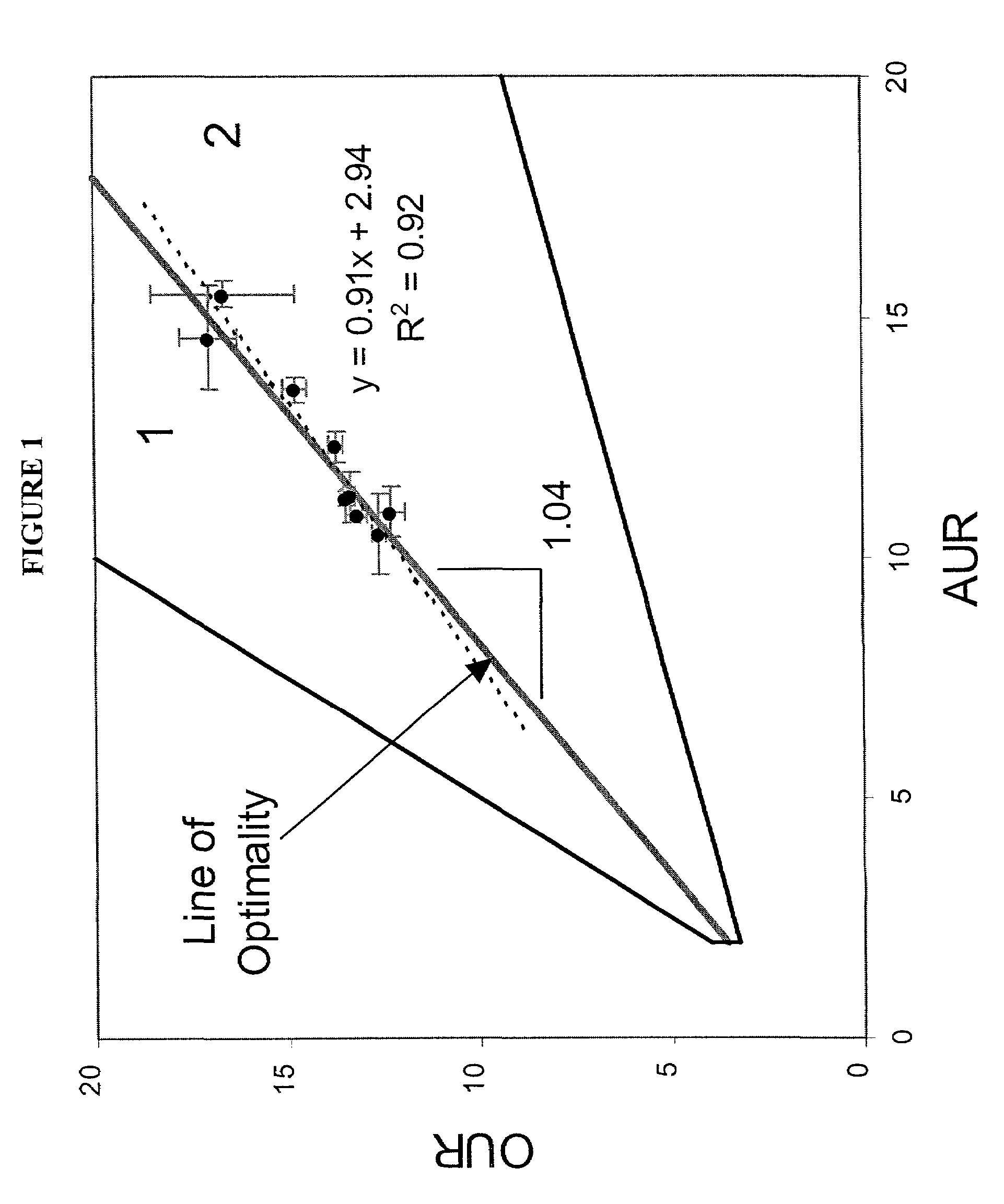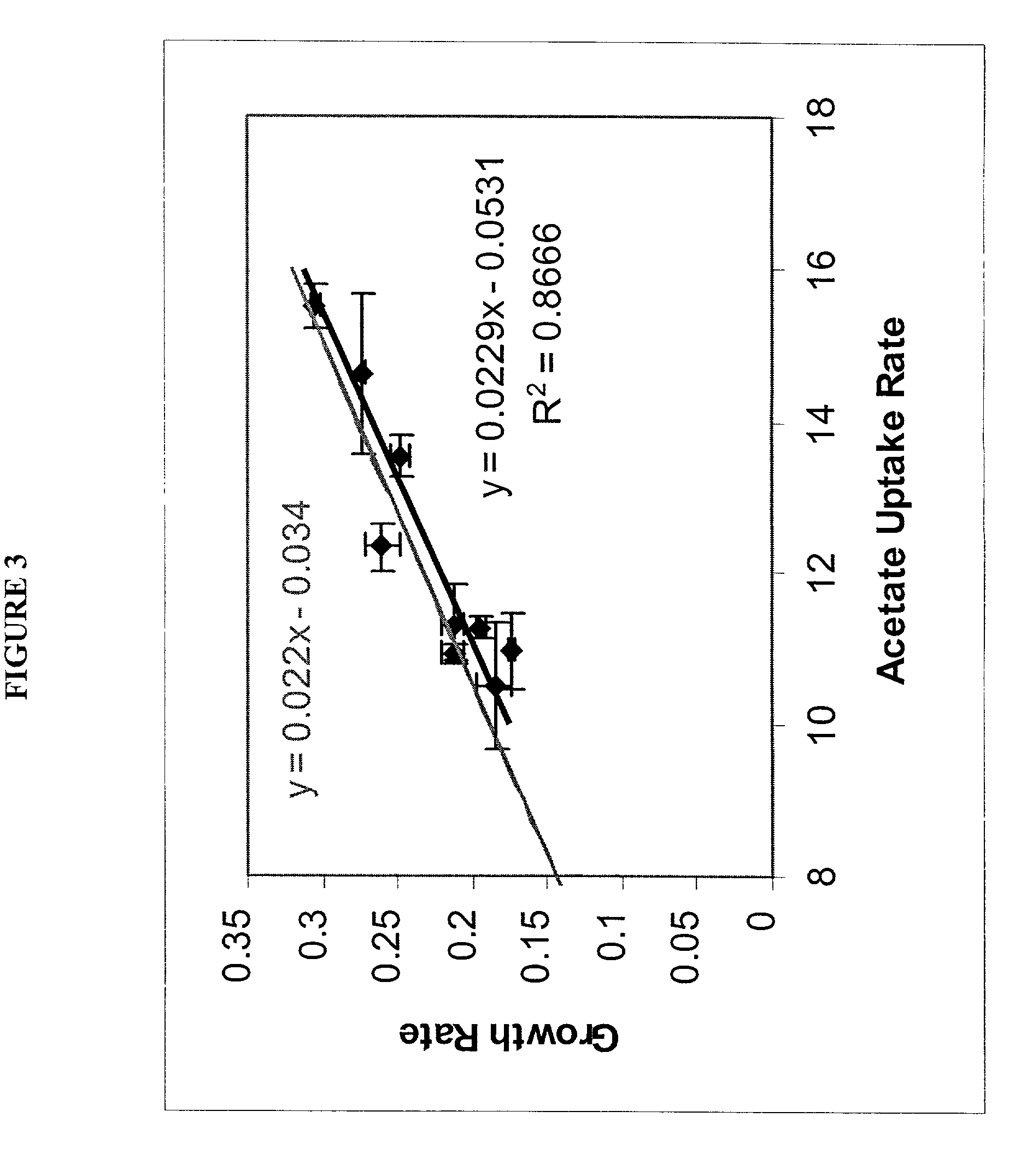Method for the evolutionary design of biochemical reaction networks
a biochemical reaction and evolutionary design technology, applied in the field of biochemical reaction networks, can solve the problems of inability to ‘splice’ one gene from one organism into another, inability to predict the effect of deleting an existing gene, and lack of methods
- Summary
- Abstract
- Description
- Claims
- Application Information
AI Technical Summary
Benefits of technology
Problems solved by technology
Method used
Image
Examples
example 1
Detailed Methods for Determination of Optimal Function and Evolution for E. coli
[0094]This example provides cultivation procedures that can be used to determine the optimality of strain performance and to carry out adaptive evolutionary processes.
[0095]Growth behavior of E. coli is determined by the following standard procedures. Growth is carried out in M9 minimal media (Maniatis et al., Molecular Cloning: A Laboratory Manual, (Cold Springs Harbor, N.Y., Cold Spring Harbor Laboratory, 545 (1982)) with the addition of the carbon source (Table 1). Cellular growth rate is varied by changing the environmental conditions, i.e. by changing the carbon source concentration approximately ranging between 0.05–4 g / L, temperature (27.5° C. to 37° C.), and oxygen (0–100% saturation relative to air). Batch cultures are set up in bioreactors at volumes of 250 mL in 500 mL flask with aeration. For these cultures the oxygen uptake rate (OUR) is monitored online, by either measuring the mass transf...
example 2
Calcuation of Optimality Properties and Phenotypic Phase Planes
[0098]This example shows how we calculate the optimality properties of the reconstructed network and how such results are represented on a phenotypic phase plane.
[0099]The capabilities of a metabolic network can be assessed using flux balance analysis (FBA) (Bonarius et al., (1997); Edwards et al., (1999); Varma et al., (1994a); Varma et al., (1994b)). FBA is primarily based on the conservation of mass in the metabolic network. The conservation requirement is implemented by stoichiometric balance equations; thus, FBA relies on the stoichiometric characteristics of the metabolic network.
[0100]The flux balance equation is S·v=bv, where S is the stoichiometric matrix, the vector v defines the metabolic fluxes, and bv is nominally zero—thus, enforcing simultaneous mass, energy, and redox balance constraints through a set of mass balances. Variations of the bv vector from zero were used in the shadow price analysis (discussed...
example 3
Optimal Behavior of E. coli Under Defined Conditions
[0114]This Example shows that the strain used exhibited optimal aerobic growth using acetate and succinate as primary substrates without adaptive evolution.
[0115]The list of metabolic reactions that take place in E. coli K-12 M1655 has been assembled (Edwards and Palsson (2000b)). Based on this list a stoichiometric matrix was formulated. Using maximal uptake rates for oxygen (on the y-axis) and a carbon substrate (on the x-axis) a phenotypic phase plane was calculated using the procedures described above. Specifically two carbon sources were used, acetate and succinate. Then the calculated phase planes were used to determine the optimal growth conditions and a series of growth experiments were performed. The computational (i.e. in silico) and experimental results were then compared.
[0116]Acetate. Optimal growth performance on acetate was investigated in silico, and the predictions generated were compared to experimental data. The ...
PUM
| Property | Measurement | Unit |
|---|---|---|
| temperature | aaaaa | aaaaa |
| volumes | aaaaa | aaaaa |
| temperature | aaaaa | aaaaa |
Abstract
Description
Claims
Application Information
 Login to View More
Login to View More - R&D
- Intellectual Property
- Life Sciences
- Materials
- Tech Scout
- Unparalleled Data Quality
- Higher Quality Content
- 60% Fewer Hallucinations
Browse by: Latest US Patents, China's latest patents, Technical Efficacy Thesaurus, Application Domain, Technology Topic, Popular Technical Reports.
© 2025 PatSnap. All rights reserved.Legal|Privacy policy|Modern Slavery Act Transparency Statement|Sitemap|About US| Contact US: help@patsnap.com



